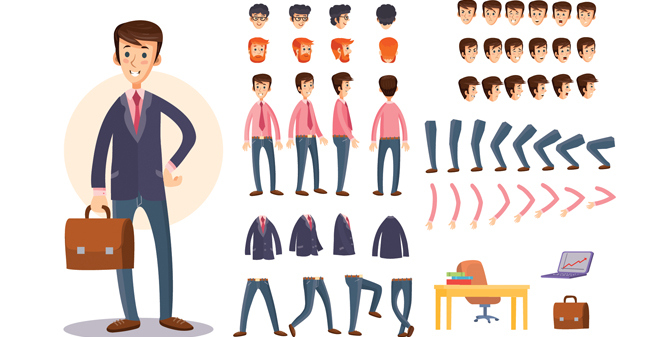Character animation is one of the persuasive tools & specialized areas in the Animation world. Character animation helps in expressing & translating the ideas & concepts in the form of different themes & stories. The art of animation aids in building & navigating the animation with immersive interactions across the globe. Animators & artists design & develop the characters & breathe them new life by using elementary animation techniques i.e., clear staging, timing, follow-through, squash & stretch, secondary action & anticipation that helps in recognizing the character that is to be created.
Character Animation expresses & communicates various thoughts & processes in a new innovative way into films, TV serials, Ads, cartoon films & programs, business presentations, social media, brand promotions, etc. Animators can best practice the creation of fascinating animated characters with the following tips & tricks:
- Analysis of Character movement: While creating any character animation, Animators should analyze & observe the human beings’ actions & movements to replicate or imitate & translate into character actions that are to be created. This actually reflects the character as natural & realistic to the finishing touch of animation while creating the storyline.
- Research on references: The characters created by animators & professional artists mostly refer to & rely upon real-world personality types to draw their characters in animation films or series of cartoon stories & bring them to life through researching on quality & traits of the characters. This study helps artists to create state-of-the-art unique characters that are loved by the audience overall.
- Gravitational influence: The physical mass of the character is affected by the animators’ gravitational works while creating the motion animation characters. The size of the character, heaviness & lightness of the character, the timely movements & speed of the character all rely on gravity works.
- Timeline actions: The timeframe of the animated film is decided & completely controlled by animators. Many irregular shots in the scene or mismatched elements from the events can result in your character animation into overactions & the audience may seem to be uninterested in viewing the film. So, adjusting the animation within varied environments such as moments of joy & sorrow can be sharply expressed in slow motion effect. Such basic factors can help animators to create films in an effective & timebound manner.
- Character Body language: The Animators know how to mold & stretch the character body movements in animation. The movement of the Character’s full-body depends on what action he is doing& under which circumstances through his body elements i.e., eyes, head, face, hands, legs & another bit of body movements in required directions & positions. The eye-catching movements of the character animation always draw the audience’s attention from the film scene.

- Saving the first copy of animation: The character body movements, actions, poses & keyframes applied to the character during animation then, these functions of animations can be saved for future purpose leaving the animations on standby that will save the animators’ time when in use & helps them concentrating on different intricacies & actions of the character in motion.
- Accepting Action, Reaction & Anticipation: The character movement primarily includes action, response to the action & expectancy are covered under character animation. The animators should be aware of these three factors & careful while creating character animation to bring to the manifestation of audiences.
- Counterpoise the Keys: The character needs to look like natural & realistic & should possess the ideal qualities that living being has in common. For instance, if a character has a tail, it has to flow like waves in motion, this might be hard in times to create the motion in direction to flow for the Animators. The base element can be animated & applied as the same in multiplication to all the remaining animation scenes in the film. This can be edited in each frame to appear the tail as the wave-like movement of the character.
- Perceive Physical Characters: Observing & studying the real-life physical characters or living beings understanding how they interact & communicate with one another in a social environment. It is significant to study the behavior, emotions & sentiments, body language, communication, etc. these aspects almost help animators to display & emote the actions into animated characters analogous to a kind of real-life characters.
- Recording the minute shots: While animating the character it is important to deeply comprehend the movements, actions & poses of the character & then record each fine move on camera. This helps you in obtaining insights into the inception of the scene you recorded. As an animator, you can always tap on the play, pause, rewind buttons to review the character animation with slow-motion foiling the animator from missing out on some critical expressions.
After all, the animator(s) intends to create & cherish the life-like state-of-the-art realistic character animation that would inspire & attract the audience’s attention incredibly. If you are looking for any kind of 3D Animation contact us today!

